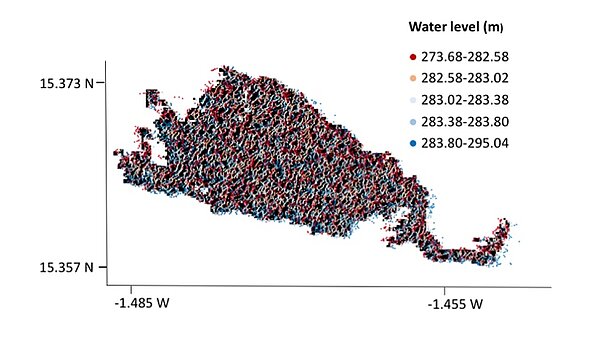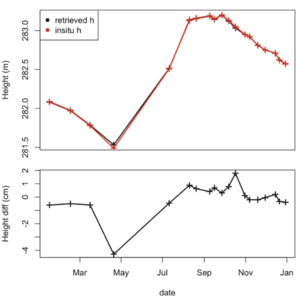Swot simulations of Sahelian ponds and lakes
Image of the Month - April 2021
Water is a vital resource everywhere, but in arid or semi-arid regions is a crucial need. The Sahelian region in Africa, south of the Sahara Desert, had undergone a severe and long precipitation deficit in the second half of the XXth century with major droughts in the 1970s-80s. However, surface water and runoff increased during and after the multidecadal-long drought, due to modifications of land surface properties (vegetation and erosion, in particular). The future evolution of water resources which will impact this region under environmental and anthropogenic changes remains unclear.
Lake and ponds are a crucial resource to people living in these areas, but in-situ monitoring networks are scarce. At the same time, very few of the small lakes in this region can be monitored by altimeters to derive water levels. Those levels can be used to assess water volumes when combined with water areas derived by imagery satellites (optical and radar). Tomorrow, Swot will provide both heights and extent over such water bodies. Using Swot high-resolution simulator, a prefiguration of the data over two of the Sahelian small lakes has been computed. The lakes were chosen for their different characteristics, and significant variations between dry and wet seasons. Results are promising and show that the 21-days repetitivity enable to monitor the seasonal cycle of these water bodies, even if short events, in particular during lakes fill up, may be missed.
Swot will thus enable to provide vital information to estimate water resources variability and runoff, including in scarcely instrumented regions.
See also:
- Applications / hydrology: lakes and enclosed seas
- Applications: High-resolution hydrology
- Missions: Swot
References:
- M. Grippa, C. Rouzies, S. Biancamaria, D. Blumstein, J-F Cretaux, L. Gal, M. Gosset, L. Kergoat, 2019, Potential of SWOT for Monitoring Water Volumes in Sahelian Ponds and Lakes, Swot Science Team meeting, Bordeaux, France, June 2019.
- Manuela Grippa, Cyprien Rouzies, Sylvain Biancamaria, Denis Blumstein, Jean-Francois Cretaux, et al.. Potential of SWOT for Monitoring Water Volumes in Sahelian Ponds and Lakes. IEEE Journal of Selected Topics in Applied Earth Observations and Remote Sensing, IEEE, 2019, 12 (7), pp.2541-2549. ⟨https://dx.doi.org/10.1109/JSTARS.2019.2901434⟩.
more information on the Sahelian paradox:
- Gal, L., Grippa, M., Hiernaux, P., Pons, L., and Kergoat, L.: The paradoxical evolution of runoff in the pastoral Sahel: analysis of the hydrological changes over the Agoufou watershed (Mali) using the KINEROS-2 model, Hydrol. Earth Syst. Sci., 21, 4591–4613, https://doi.org/10.5194/hess-21-4591-2017, 2017.






